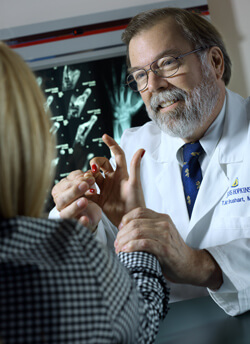
Johns Hopkins Orthopaedic Surgery
December 10, 2014

The patient had inclusion body myositis or IBM, a myopathy that progressively weakens the muscles of the wrists and fingers including the flexor pollicis longus, the flexor digitorum profundus and the flexor digitorum superficialis. IBM also weakens the quadriceps and the peroneal nerve innervated muscles on the anterior aspect of the lower leg that extend the ankle. The myopathy tends to occur more frequently in men than in women, and symptoms usually begin after age 50.
Brushart, who works closely with the neuromuscular division of Johns Hopkins’ departments of neurology and neurosurgery, has fostered a unique collaboration in neuromuscular reconstruction. “We design tendon transfers based on a patient’s physical exam and disease process,” Brushart says. “We look to see which muscles are still working, and of those, which ones we can spare and reassign to a new job.”
For patients with IBM, the team devised an outpatient procedure that includes a bone fusion in the fingers and a simple tendon transfer. “At this stage we transfer one of the three muscles that extend the wrist, the extensor carpi radialis brevis, to the profundi of the four fingers to restore finger flexion,” Brushart says. “We give patients improved function for several years during the disease process. The procedure takes the patient from having a hand that barely works to having one that works pretty nicely.”
Another area where Brushart and his neurology colleagues join forces is repairing damage caused by Charcot-Marie-Tooth disease, a common neurological disorder that causes distal myopathy. “The small muscles in the hand atrophy, and patients can’t pinch things or grab with their thumb,” says Brushart. “We take some of the muscles that are working normally above the hand to repower the ones below. Once we do our reconstruction, what’s been fixed will work for patients indefinitely.”
With Neurology right next door to Brushart’s clinic, patients considering neuromuscular reconstruction can get diagnostic tests like electromyographies or nerve conduction studies on the same day they are ordered. The physical proximity also means that Brushart and his colleagues can quickly discuss test results.
“Nowhere else is the concentration of expertise in hand surgery, neurosurgery and neurology all in one place to treat nerve injuries and neuromuscular diseases with a surgical approach,” says Brushart.
After such procedures, patients’ quality of life improves dramatically. “Whether the disease is something that causes muscular damage and then stops or is one that is inexorably progressive,” says Brushart, “we can help.”

